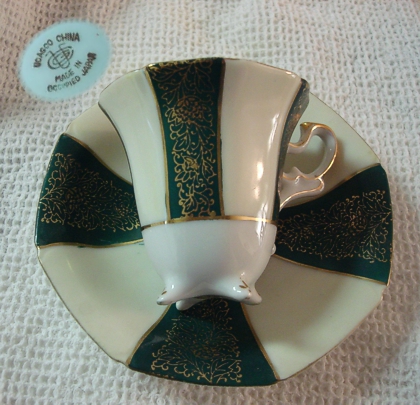During the post-World War II years, the USA spent a great deal of money and manpower to help our former enemies rebuild their economies. One of these projects in Japan was the re-establishment of ceramics production.

An Occupied Japan cup and saucer that I found in a local antiques shop several years ago. (Photo source: article author)
While Japan had a centuries-old tradition of ceramics (stoneware, china, porcelain) ranging from functional to decorative before the war, many of the factories were damaged during the fighting and skilled workers were in short supply. At war?s end, former factory workers and artisans found their way home and began to take up their jobs in the ceramics industry.
At first Americans back home were reluctant to buy products from Japan. The main outlet for them was the PX, or post exchange: the store on the base where military personnel and their families shopped. Obviously our GIs felt that helping the Japanese rebuild their economies included being their customers. By about 1948 American ill will against the Japanese people had subsided enough that goods from Japan were once again welcomed in USA markets.
Ceramics produced in Japan between 1945 and 1952 were identified as being made in occupied Japan. Most of the pieces bear markings of this period: Made in Occupied Japan, or just Occupied Japan. Because this period lasted less than seven years, many of the pieces created during the occupation have become rare and quite valuable.
Briefly, ceramics require two firings (baking in a super-hot oven called a kiln): the first, or bisque, firing that produces a solid, semi-porous object; followed by the glaze firing, in which a combination of minerals applied to the object and then heated become vitreous, thus rendering the object impervious to liquids.
The ceramics created in Occupied Japan were generally made of a white clay, or kaolin, which is used to produce porcelain. Most of the objects, however, were produced as china, which is fired at a lower temperature than porcelain.
While the majority of Occupied Japan china comprised figurines or other figural items (mugs, salt and pepper shakers, vases, and the like), a great number of tea wares were also produced. Many of these took the form of miniature tea sets and children?s tea sets. You can also find a few teapots and full-size tea sets. The majority of tea wares produced in Occupied Japan, however, were teacups ? and some very beautiful ones at that.
When shopping for Occupied Japan china, look for the identifying marks stamped on the bottom. Although there have been some forgeries, most objects carrying the Occupied Japan stamp tend to be genuine. On the other hand, some Occupied Japan china is, unfortunately, not marked as such, and requires a ceramics expert to correctly identify it. There are also some specific factory names you can look for: Ucagco is one of these. Other pieces are signed by the individual artisan.
Occupied Japan china can be found at antiques and collectibles shops, yard sales, and via online sellers, and vary widely in price. Once you find a piece that you love, it?s up to you to decide whether the asking price is worth it.
? Online Stores, Inc., and The English Tea Store Blog, 2009-2014. Unauthorized use and/or duplication of this material without express and written permission from this article?s author and/or the blog?s owner is strictly prohibited. Excerpts and links may be used, provided that full and clear credit is given to Online Stores, Inc., and The English Tea Store Blog with appropriate and specific direction to the original content.
Like this:
Be the first to like this.
Source: http://englishtea.us/2012/11/28/tea-wares-from-occupied-japan/
whitney houston autopsy dobie gray bruce springsteen grammy nominations lil boosie bobbi kristina brown new edition
No comments:
Post a Comment
Note: Only a member of this blog may post a comment.